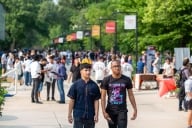You have /5 articles left.
Sign up for a free account or log in.
The past academic year is noteworthy in our family because it was the time of our first granddaughter’s senior year in high school—and that means a year of college exploration, application, anxiety, acceptance and, finally, commitment. It was also a year when I viewed colleges from a new perspective—as an outsider looking in with high hopes that my granddaughter would find the happiness and fulfillment she was seeking.
This outside perspective was new to me. For my entire adulthood, higher education has been my life, going straight from my student experience (B.A., M.A., Ph.D.) to faculty and administrative roles at private and public universities across the country. Now as an adviser at the American Council on Education, I am deeply involved in higher education reform.
But this grandmother-of-a-college-applicant role was new. While I’m pleased that universities seek my advice, 17-year-olds have to do things their way—and that’s a good thing. My role during the college search was that of an observer. Seeing the college search through a teenage lens was illuminating. Since my granddaughter falls into the much-sought-after and diminishing category of traditional-age college student, I thought that some of my observations might be useful to colleagues who are working hard to attract students in this demographic.
First, full disclosure, our granddaughter and her parents did operate under certain axioms that they picked up almost by osmosis from living in an academic family:
- Ignore U.S. News & World Report rankings.
- Eliminate all colleges and universities in states that compromise reproductive health.
- Take advantage of the first year of college to explore majors.
- Remember that a liberal arts education is the foundation of everything, but look for colleges that explicitly apply the liberal arts to potential careers.
- Recognize that the first-year experience is important.
In other areas the teenage sensibility was dominant. Here is what I learned:
College visits are essential. Teenagers make college decisions on the “feel” of the place. Are those walking around the campus people like herself in interests, values and (they’re teenagers!) ways of dressing? In the adolescent mind, the biggest worry is “Will I make friends?”
Early action is desirable. Even academically well-prepared kids worry that they will be rejected everywhere. The possibility of an early acceptance from a selected college is a great anxiety reliever. Early action is preferable to early decision because students do want to retain a wider choice and the option of changing their minds.
Social media influencers do influence. This was a new one for me. Some colleges encourage (employ?) students to post attractive photos and descriptions on social media. I was somewhat baffled by high school seniors’ interest in what they called “a college town.” Not every campus has Princeton’s Nassau Street or Brown’s Thayer Street, but these social media influencers manage to portray other campuses as picture-book perfect.
A warm, individualized admissions letter is crucial. Among her admissions letters, our granddaughter received one from the associate dean who interviewed her during her campus visit. It welcomed her to the Class of 2027 and invited her to come and chat about Kurt Cobain, the subject of one of her application essays. What a great way to let a kid know that she was seen and respected as a thinking individual! Our granddaughter ultimately accepted this college’s offer.
In all correspondence with students, remember that they are vulnerable and nervous. It’s difficult to believe that some institutions that I had formerly positive feelings about were oblivious to student feelings. Two days before the April 1 deadline for acceptances, our granddaughter, who had not heard from a particular college, received a voice mail from a student recruiter suggesting a conversation. To no avail, she tried to schedule the conversation for the next day and spent two sleepless nights wondering if the call meant that she was accepted. During the following week—after the April 1 deadline—she found out she was wait-listed. At least this experience eliminated any thought of attending that college.
Develop a website that makes it easy to find in-depth information about the first-year experience and pertinent points about the college. Everyone looks at the website—students, parents and grandparents. I was astonished to discover the difficulty in finding information: Is there a first-year experience? What about paid internships, writing across the curriculum and study abroad? Does the advising program help the student to put personal mission (what she wants to achieve in life) before the choice of a specific major?
As someone who has devoted much of her career to improving higher education for nontraditional students (first generation and adults), I realize that our granddaughter’s experience is privileged from the get-go. All of us in higher ed must continue to improve access for students who can’t afford to make college visits and don’t know the ropes of applying to college. Since colleges and universities devote extraordinary resources to reaching traditional college-age students like our granddaughter, I thought that the above tips might be useful and could perhaps free up additional resources and energy for recruiting students who don’t fall within the traditional-student category.
If you are wondering what college our granddaughter will attend, take a look at New England college websites and see if you can guess. For my part, I’m looking forward to the vicarious pleasure of visiting the chosen college at Friends and Family weekend in October.








